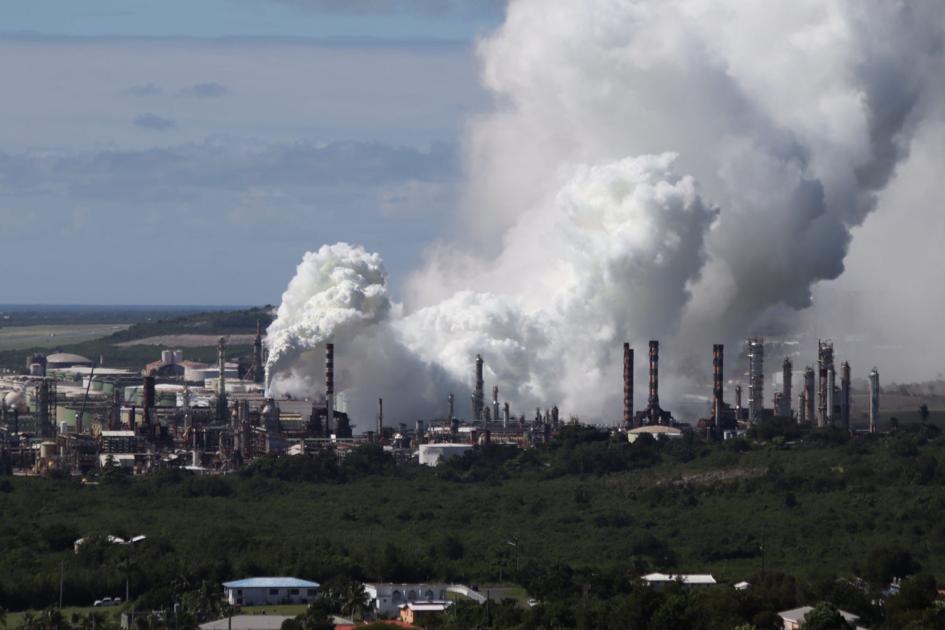FREDERIKSTED — Commissioner Jean-Pierre L. Oriol of the Department of Planning and Natural Resources (DPNR) is advising the community that the department is aware of a foul, gaseous smell permeating throughout the Frederiksted area for the past few days.
DPNR’s Air Quality Management Program staff has responded to citizen’s complaints and has discovered that the Limetree Bay Refinery is experiencing an exceedance of Hydrogen sulfide.
Hydrogen sulphide (H2S) is a highly toxic gas. Accidental deaths following H2S exposure is a known hazard amongst petroleum workers exposed to by-products of refineries. Toxicity results mainly due to cellular respiratory poisoning which impairs oxidative phosphorylation.
DPNR is advising the public that persons with respiratory ailments such as allergies, lung disease, and asthma should consider taking protective actions. Protective actions include staying indoors or relocating to areas less affected.
According to the federal Occupational Safety and Health Administration, effects from hydrogen sulfide, a colorless gas known for its pungent rotten egg odor, range from mild to very serious headaches or eye irritation, unconsciousness and death. OSHA warns that individuals lose the ability to smell hydrogen sulfide after continued exposure, something that can happen rapidly at high concentrations.
By 11 a.m. today, the St. Croix Career and Technical Education Center, Arthur A. Richards K-8 School and Eulalie R. Rivera K-8 School had called parents to pick up their students.
But reportedly, DPNR had been hearing since Monday that residents had been smelling and becoming sick from the odor. Limetree reported the exceedance to DPNR on Thursday.
Akeel Phillips, who lives close to the refinery, told The Daily News he had been smelling the odor since Monday.
“I noticed this funny odor outside, and I bought all these different air fresheners but was still getting the smell,” Phillips said. “I’ve been getting these crazy headaches. The smell was just ridiculous.”
Several miles away in Frederiksted, Jennifer Valiulis said she was awakened by the odor today. The acting executive director of the St. Croix Environmental Association put a blanket over her face to block out the odor, which caused her eyes and lungs to burn, she said.
“Something is happening at the refinery, but it hasn’t been transparent at all,” Valiulis told the Virgin Islands Daily News.
Her organization has joined three others to challenge the U.S. Environmental Protection Agency’s permit for Limetree Bay.
Issued under the Trump administration, the EPA’s permit gave Limetree Bay Ventures wider latitude to control its emissions and allowed for higher levels under the plant’s reduced capacity from when it closed under former owner HOVENSA in 2012. Protesting the makings of “an environmental monster,” the St. Croix Environmental Association and its fellow environmental groups faulted the EPA for setting lenient air pollution standards in a community of color, where 27 percent of residents live below the poverty line.
The EPA withdrew the permit for further study under pressure from environmental groups on March 26.
Although the problem has been corrected according to Parsons, questions about the refinery’s emission levels, oversight and pollution control equipment persist.
“EPA is aware of the recent air release at the Limetree Bay facility and our acting Regional Administrator Walter Mugdan spoke to VIDPNR Commissioner J.P. Oriol earlier today to get an update on the Department’s response to this incident, which EPA and DPNR are taking very seriously,” EPA spokesman John Senn emailed The Daily News.
“We will work with VIDPNR and Limetree to quickly gather information regarding this incident, including causes of the release and the current operating status of all units,” Senn wrote.
Since shutting down the refinery on April 7 to make operational adjustments, Limetree has not yet given the EPA a timeline for the startup and operating status of each unit, Senn said.
Meanwhile, neither the federal or territorial environmental agencies can answer questions about the refinery’s emissions and pollution control equipment, they said.
Emissions problems go back to HOVENSA’s violations of the Clean Air Act, which were settled — but not resolved — by the EPA and U.S. Department of Justice in 2011. At the time, the EPA said that the plant’s high emissions could have adverse impacts on human health.
According to EPA literature, refineries can reduce emissions to insignificant levels. But some refineries flare the gases routinely, resulting in uncontrolled releases of sulfur dioxide, the EPA found.
The agency is looking over six weeks of exceedance data to see if there is a pattern of problems with the startup of refining operations.
Limetree has seven days to give DPNR a report citing the specific cause of the hydrogen sulfide exceedance.
“The environmental crisis of the refinery on St. Croix continues despite recent slaps from the EPA from their airborne oil emissions,” St. Croix farmer and activist Nate Olive posted on Facebook.
“What are the senators who voted it into existence (or not) doing about it?” Olive posted.
To report issues or concerns, the public can contact Limetree’s Command Center at 340-692-3000, the facility’s information hotline at 340-692-3199 or email to: communications@lbenergy.com.
DPNR will continue to monitor this situation and advise the community accordingly. If you have any questions or concerns, please call (340) 773-1082 ext. 2252

